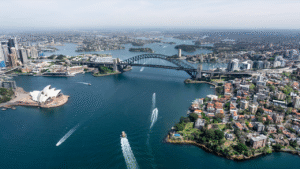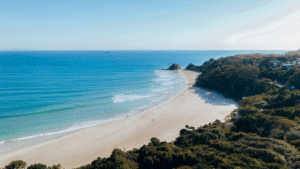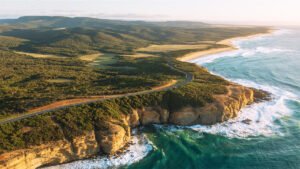Estimated reading time: 19 minutes
Key Takeaways
- The Blue Mountains is a UNESCO World Heritage area just 1.5-2.5 hours from Sydney
- Visit iconic landmarks like the Three Sisters rock formation and panoramic Jamison Valley viewpoints
- Choose from multiple transportation options including train, car, or guided tours
- Explore stunning hiking trails such as the Prince Henry Cliff Walk and Grand Canyon Walk
- Experience the Blue Mountains Scenic World cableway for breathtaking aerial views
- Spring (Sept-Nov) and autumn (Mar-May) offer the best weather conditions for your visit
Table of Contents
- Introduction
- Getting Ready for Your Blue Mountains Day Trip from Sydney
- Must-See Attractions in the Blue Mountains
- Outdoor Adventures and Hiking Options
- Unique Attractions and Scenic Rides
- Sample Itinerary and Additional Tips
- Conclusion
Introduction
A Blue Mountains day trip from Sydney is the perfect escape for nature lovers and adventure seekers. Located just a short distance from Australia’s largest city, this stunning mountain range offers dramatic landscapes, ancient forests, and cascading waterfalls that create an unforgettable natural wonderland. As a UNESCO World Heritage area, the Blue Mountains showcase Australia’s natural beauty at its finest.
The region gets its name from the distinctive blue haze created when sunlight filters through tiny droplets of eucalyptus oil released by the vast forests. This natural phenomenon creates the signature blue appearance that gives these mountains their iconic name and adds to their mystical character.
Visitors are drawn to famous landmarks like the Three Sisters rock formation and the numerous hiking trails that wind through lush valleys and along clifftops. The accessibility and variety of attractions make the Blue Mountains ideal for day trippers from Sydney looking to experience the Australian wilderness without venturing too far from urban comforts.
Want to see this for yourself? Click here to jump to this part of the video.
Getting Ready for Your Blue Mountains Day Trip from Sydney
Travel Tips and Transportation Options
There are several convenient ways to reach the Blue Mountains from Sydney, each offering a different experience:
- By Car: Driving gives you the most flexibility to explore at your own pace. Take the M4 Motorway west from Sydney, which leads directly to the Blue Mountains. The journey typically takes 1.5-2.5 hours depending on traffic and your specific destination. Be prepared for tolls along the M4, and remember that parking can fill up quickly at popular spots, especially on weekends and holidays. [SOURCE]
- By Train: For a hassle-free journey, catch a train from Sydney’s Central Station. Blue Mountains Line trains depart approximately every 30 minutes and stop at key destinations like Katoomba, Leura, and Wentworth Falls. The train journey takes about 2 hours to Katoomba (the main hub for Blue Mountains attractions) and costs around $6-10 each way with an Opal card. The scenic railway journey itself is part of the experience, with beautiful views along the way. [SOURCE]
- Guided Tours: If you prefer a structured experience with transportation included, numerous tour operators offer day trips from Sydney. These typically include visits to major attractions like the Three Sisters, Scenic World, and various lookouts. Many tours also provide knowledgeable guides who share insights about the region’s history, flora, and fauna. Tours generally depart Sydney around 7:00 am and return by 6:00-7:00 pm, with prices starting from approximately AU$99 per person. [SOURCE]
Ideal Time to Visit the Blue Mountains
The Blue Mountains are beautiful year-round, but certain seasons offer distinct advantages:
- Spring (September-November): Perhaps the most delightful time to visit, with mild temperatures (typically 15-22°C/59-72°F), blooming wildflowers, and fewer crowds than summer. The gardens in towns like Leura and Mount Wilson are particularly stunning during this season.
- Autumn (March-May): Another excellent choice, featuring pleasant temperatures, clear skies, and beautiful autumn foliage in certain areas, especially around Mount Wilson and the botanic gardens.
- Summer (December-February): Warmest months (usually 23-29°C/73-84°F) with longer days for exploring, though popular spots can get crowded, and occasional thunderstorms may occur in the afternoons.
- Winter (June-August): Cooler temperatures (5-16°C/41-61°F) mean fewer tourists. The crisp air creates magical misty mornings, and you might even experience occasional snow in higher elevations like Blackheath.
For the best experience with smaller crowds, consider visiting on weekdays. Weekend visitors benefit from the Opal card’s daily fare cap on Sundays, making train travel more economical. [SOURCE]
What to Pack for Your Day Trip
Proper preparation ensures a comfortable day out from Sydney. Here’s what to bring:
- Clothing: Dress in layers, as mountain temperatures can be 3-5°C cooler than Sydney and can change quickly throughout the day. A light jacket or windbreaker is recommended even in summer.
- Footwear: Comfortable, sturdy walking shoes or hiking boots are essential, as many of the best experiences involve walking on uneven surfaces, stairs, and trails.
- Sun protection: Hat, sunglasses, and sunscreen are necessary year-round, as the Australian sun can be intense even on cloudy days.
- Water and snacks: Bring at least 1-2 liters of water per person and pack some energy-boosting snacks, especially if planning to hike.
- Camera: The Blue Mountains offer countless photo opportunities, so don’t forget your camera or ensure your phone has enough battery life.
- Rain gear: A small umbrella or light rain jacket can be handy, as mountain weather can be unpredictable.
- Small backpack: To comfortably carry all your essentials while keeping your hands free for hiking and photography.
If traveling by public transport, bring your Opal card (or contactless payment card) for seamless travel on trains and buses. [SOURCE]
Must-See Attractions in the Blue Mountains
Three Sisters Blue Mountains Lookout
The Three Sisters is arguably the most iconic natural formation in the Blue Mountains and a must-visit on any day trip from Sydney. These three distinctive sandstone pillars, towering about 900 meters (3,000 feet) above the Jamison Valley, have become the defining image of the region.
According to Aboriginal Gundungurra Dreaming, the rocks represent three sisters named Meehni, Wimlah, and Gunnedoo who were turned to stone by a tribal elder to protect them from danger. The elder, who possessed magical powers, intended to reverse the spell after the threat passed, but was himself transformed, leaving the sisters as eternal stone sentinels overlooking the valley. [SOURCE]
The best place to view the Three Sisters is from Echo Point Lookout in Katoomba. This well-developed viewing platform offers spectacular panoramic views not only of the rock formation but also of the vast Jamison Valley stretching into the distance. Informative signs explain both the geological and cultural significance of the site.
For an even closer look, follow the short path from Echo Point to Honeymoon Bridge, a walkway that connects to the first of the Three Sisters. This gives you a unique perspective and a chance to actually stand on one of these famous rock formations. [SOURCE]
Echo Point can get very busy during peak times (midday on weekends and holidays), so consider visiting earlier in the morning or later in the afternoon for a more peaceful experience and better lighting for photography.
Jamison Valley Viewpoints
While the Three Sisters deservedly capture much attention, the panoramic views of Jamison Valley are equally breathtaking. This vast wilderness of eucalyptus forests, sandstone cliffs, and hidden waterfalls creates a stunning backdrop that showcases the natural grandeur of the Blue Mountains.
Several outstanding lookouts provide different perspectives of the valley:
- Echo Point: Beyond the Three Sisters view, this main lookout offers sweeping vistas of the valley floor and distant blue-tinted ridges. The information center here provides context about the region’s geology and ecology.
- Queen’s Cascade: Located near Wentworth Falls, this lookout presents dramatic views of the cascading waterfall as it drops into the valley, particularly impressive after rainfall.
- Eagle Hawk Lookout: A less crowded alternative with panoramic views along the cliff line, perfect for those seeking a quieter experience away from the main tourist areas. [SOURCE]
- Cahill’s Lookout: Situated near Boar’s Head Rock in Katoomba, this viewpoint offers magnificent sunset views as the last light bathes the sandstone cliffs in golden hues.
For photography enthusiasts, the best lighting conditions occur during the “golden hours” of early morning and late afternoon. The morning light creates a magical effect as it illuminates the valley and burns off the misty haze, while the evening light casts rich, warm tones across the landscape.
The distinctive blue haze that gives the mountains their name is caused by light scattering through fine droplets of eucalyptus oil released by the vast forests. This natural phenomenon is most visible on warm days and creates an almost dreamlike quality to your photographs.
Outdoor Adventures and Hiking Options
Best Hikes Blue Mountains
The Blue Mountains offer a vast network of hiking trails suitable for all fitness levels, from easy strolls to challenging full-day adventures. Here are some of the best hikes to consider for your day trip:
- Prince Henry Cliff Walk: This 7km trail connects major lookouts between Katoomba and Leura, offering stunning views of the Jamison Valley and Three Sisters. The relatively flat path makes it accessible for most visitors, and you can join or exit at multiple points, allowing you to customize the length of your walk. The diverse scenery includes dramatic clifftops, sheltered forests, and small waterfalls. [SOURCE]
- Wentworth Falls Loop: This moderate 5km circuit showcases one of the Blue Mountains’ most spectacular waterfalls. Starting at Wentworth Falls picnic area, the track descends via stone stairs to reveal increasingly dramatic views of the 187-meter tiered waterfall. The National Pass section follows a ledge halfway up the cliff face, offering breathtaking perspectives of the valley. Return via the Overcliff-Undercliff Track for varied scenery. [SOURCE]
- Govetts Leap to Pulpit Rock: This 3-hour return walk near Blackheath connects two remarkable lookouts. The trail follows the cliff edge with continuous valley views and passes several smaller waterfalls along the way. Pulpit Rock offers a unique perspective, jutting out from the cliff face for a 280-degree panorama.
- Leura Cascades to Gordon Falls: A shorter 2.1km walk perfect for families or those with limited time. This shaded track follows a picturesque stream with several small waterfalls and lookouts along the way.
For all hikes, be sure to check track conditions before setting out, carry adequate water, and wear appropriate footwear. The Blue Mountains weather can change rapidly, so be prepared with layers even on seemingly clear days.
Grand Canyon Walk Blue Mountains
The Grand Canyon Walk is often regarded as the crown jewel of Blue Mountains hiking experiences. This 6.3km loop track near Blackheath offers a completely different perspective from the clifftop lookouts, taking you down into a lush, prehistoric-feeling ravine carved over millions of years.
The trail begins at Evans Lookout and descends into the canyon through a series of stone steps. Once on the canyon floor, you’ll be immersed in a magical environment of towering coachwood and sassafras trees, delicate ferns, moss-covered rocks, and the constant sound of running water. The trail follows Greaves Creek, crossing it several times via stepping stones and small bridges as it winds through the canyon. [SOURCE]
Highlights of the walk include:
- Beauchamp Falls – a picturesque waterfall cascading into a serene pool
- Massive sandstone overhangs and cave-like formations
- The cool microclimate of the canyon floor, which supports unique plant species
- Dramatic walls rising on both sides, creating striking light effects when the sun filters through
The track is rated moderate to difficult, primarily because of the 900+ steps you’ll encounter throughout the journey. While the path is well-maintained with stone steps and boardwalks in sections, it requires a reasonable level of fitness. Allow 3-4 hours to complete the loop at a comfortable pace with time for photos and rest breaks.
Safety considerations for the Grand Canyon Walk:
- Start early in the day to ensure you have plenty of time to complete the circuit before dusk
- Wear sturdy shoes with good grip, as sections of the track can be slippery
- Bring at least 1-2 liters of water per person
- The canyon floor is much cooler than the surrounding areas, so a light jacket is recommended
- Mobile phone reception is limited or non-existent within the canyon
The Grand Canyon Walk provides a completely different Blue Mountains experience compared to the clifftop vistas, making it worth including in your itinerary if you have a full day and enjoy hiking. The contrast between the arid clifftops and the lush, prehistoric-feeling canyon creates a truly memorable adventure.
Unique Attractions and Scenic Rides
Blue Mountains Scenic World Cableway
Scenic World, located in Katoomba, offers visitors a unique way to experience the Blue Mountains through a series of remarkable rides, with the Scenic Cableway being one of the most popular attractions. This aerial gondola provides an exhilarating yet comfortable way to access the ancient rainforest floor without the strenuous hiking typically required.
The Scenic Cableway is the largest aerial cable car in the Southern Hemisphere, and descends 545 meters (1,788 feet) into the Jamison Valley. The spacious cabin features floor-to-ceiling windows and a glass floor section, ensuring 360-degree views as you glide between the cliff top and valley floor. [SOURCE]
During the 5-minute journey, passengers are treated to spectacular perspectives of:
- The Three Sisters rock formation from a unique angle
- Katoomba Falls as it cascades down the sandstone cliff
- The vast expanse of the Jamison Valley
- The dense canopy of the ancient Jurassic rainforest below
At the valley floor, you can access the 2.4-kilometer Scenic Walkway, an elevated boardwalk that winds through the temperate rainforest. This gentle walk is suitable for all ages and abilities, allowing visitors to immerse themselves in the ancient ecosystem with minimal impact on the environment. Informative signs along the route highlight interesting flora, fauna, and the area’s coal mining history.
Scenic World offers several ticket options:
- Unlimited Discovery Pass: Provides all-day access to the Cableway, Skyway, Railway, and Walkway (approximately AU$54 for adults, AU$32 for children)
- Family passes: Available at discounted rates for families of 4-5 people
- Annual passes: For those who plan to visit multiple times
For hikers, the Cableway offers a practical solution to create loop walks instead of out-and-back trails. For example, you can descend via the Furber Steps (a steep stairway near Scenic World), explore the valley floor, and return via the Cableway—or vice versa. This strategy saves energy and provides varied perspectives of the landscape.
The Scenic World complex also includes:
- Scenic Railway: The steepest passenger railway in the world with a 52-degree incline, originally built for the coal mining industry
- Scenic Skyway: A horizontal cableway suspended 270 meters above the valley, featuring a glass floor and spectacular views of Katoomba Falls and the Three Sisters
- Dining options: From casual cafés to more formal restaurants with valley views
- Gift shop: Offering local products and souvenirs
Scenic World operates daily from 9:00 am to 5:00 pm, with extended hours during peak holiday periods. Lines can be long during weekends and school holidays, so visiting early in the day or mid-week is recommended for a more relaxed experience. [SOURCE]
Sample Itinerary and Additional Tips
Suggested Blue Mountains Day Trip Itinerary
Here’s a practical itinerary to help you make the most of your Blue Mountains day trip from Sydney:
- 7:00 AM: Depart Sydney by car (via M4 Motorway) or catch an early train from Central Station (the 7:25 AM Blue Mountains Line train is ideal)
- 9:00-9:30 AM: Arrive in Katoomba. If you’re hungry, grab a quick breakfast or coffee at one of the cafés on Katoomba Street
- 9:45 AM: Head to Echo Point Lookout to see the Three Sisters before the large tour groups arrive. Take your time to appreciate the views and read about the Aboriginal legends
- 10:30 AM: Walk a portion of the Prince Henry Cliff Walk to enjoy different perspectives of the Jamison Valley. If time permits, take the short track to Honeymoon Bridge to stand on the first Sister
- 11:30 AM: Visit Scenic World. Begin with the Skyway for aerial views, then descend to the valley floor via the Cableway. Explore the rainforest boardwalk before returning to the top via the Railway
- 1:00 PM: Lunch break. Choose from restaurants at Scenic World, pack a picnic to enjoy at a lookout, or head to Leura for its charming cafés and restaurants
- 2:00 PM: Afternoon hiking or exploring options:
- Option 1: Drive or take a local bus to Wentworth Falls for a 1-2 hour walk to see the magnificent waterfall and valley views
- Option 2: For more serious hikers, drive to Blackheath for the Grand Canyon Walk (allow 3-4 hours)
- Option 3: Explore the charming town of Leura, with its gardens, boutiques, and antique shops
- 4:30 PM: Visit one final lookout point, such as Govetts Leap near Blackheath or Eagle Hawk Lookout for sunset views
- 5:30-6:00 PM: Begin your return journey to Sydney, either by car or catching an evening train from Katoomba Station
This itinerary provides a good balance of iconic sights, natural experiences, and local culture while avoiding excessive rushing between locations. It’s flexible enough to adapt based on your interests, fitness level, and the weather on the day of your visit. [SOURCE]
Additional Tips for Your Visit
Dining Recommendations:
- In Katoomba: The Carrington Hotel for historic elegance, Palette Dining for modern Australian cuisine, or Yellow Deli for a cozy, rustic experience
- In Leura: Red Door Café for breakfast and lunch, Leura Garage for innovative dishes in a converted mechanic’s workshop, or The Wayzgoose Café for homemade pies and cakes
- Picnic Options: Stock up at Hominy Bakery in Katoomba or Leura’s gourmet delis for takeaway items to enjoy at scenic spots [SOURCE]
Parking Strategies:
- Arrive early (before 10 AM) at major attractions like Echo Point and Scenic World to secure parking, especially on weekends
- Consider parking once in Katoomba or Leura and using local buses or walking between nearby attractions
- Look for free all-day parking on side streets a short walk from main attractions
- Some viewpoints have time-limited parking (2-4 hours), so check signage carefully
Tour Booking Tips:
- For families: Choose tours that include Scenic World rides and shorter walks suitable for children
- For solo travelers: Consider small-group tours that offer a social experience and access to places harder to reach by public transport
- For photography enthusiasts: Look for tours that visit lookouts during optimal lighting conditions or specialty photography tours
- For adventure seekers: Some operators offer tours combining sightseeing with activities like abseiling, canyoning, or mountain biking
Weather Considerations:
- Check the forecast before departing Sydney—weather in the mountains can differ significantly from the city
- Foggy conditions, while limiting distant views, create magical, atmospheric experiences in the forests
- Have a backup plan for rainy days, such as visiting Jenolan Caves (further west) or exploring the indoor attractions in towns like Leura and Katoomba
- The Blue Mountains can be up to 10°C cooler than Sydney, particularly at higher elevations like Blackheath
For travelers with specific interests, consider adding these specialized experiences to your itinerary:
- For history buffs: Visit the Hydro Majestic Hotel in Medlow Bath, a restored art deco gem with panoramic valley views
- For art lovers: Explore the Norman Lindsay Gallery and Museum in Faulconbridge, former home of the famous Australian artist
- For garden enthusiasts: The Blue Mountains Botanic Garden at Mount Tomah showcases cool-climate plants from around the world
- For wildlife spotting: Dawn and dusk walks offer the best chances to see native animals like wallabies, lyrebirds, and cockatoos
A visit to the Blue Mountains can be tailored to suit almost any travel style, from relaxed sightseeing to active adventure, making it one of the most rewarding day trips from Sydney.
Conclusion
A Blue Mountains day trip from Sydney offers a perfect escape into one of Australia’s most stunning natural landscapes. In just a single day, you can experience the breathtaking majesty of ancient sandstone cliffs, lush eucalyptus forests, and iconic landmarks that have captivated visitors for generations.
From the moment you arrive and gaze out at the Three Sisters rock formation to your final sunset view over the vast Jamison Valley, the Blue Mountains provide a refreshing contrast to Sydney’s urban energy. The region’s accessibility makes it possible to pack a variety of experiences into a day trip—from scenic lookouts and cultural sites to hiking trails and unique attractions like the Scenic World cableway.
What makes the Blue Mountains truly special is how it offers something for everyone. Casual visitors can enjoy spectacular views with minimal walking, families can mix adventure with education, and hiking enthusiasts can challenge themselves on world-class trails. The natural wonders are complemented by charming mountain towns, excellent dining options, and rich cultural heritage.
Whether you choose to drive yourself, take the train, or join a guided tour, proper planning using the tips in this guide will help you maximize your time and create lasting memories. Consider the season and weather when planning your visit, pack appropriately, and prioritize the attractions that most appeal to your interests.
While a day trip allows you to experience many highlights, the Blue Mountains’ magic might inspire you to return for a longer stay to discover more of its hidden treasures. Many visitors find themselves drawn back to explore different seasons, alternative hiking trails, or simply to spend more time soaking in the peaceful atmosphere that has made this region a favorite escape for Sydneysiders and international travelers alike. [SOURCE]
For more stunning travel documentaries featuring natural wonders like the Blue Mountains, be sure to visit Pathfinders Travel on YouTube, where you can watch Wonders of the World Travel Documentaries in 4K resolution.













